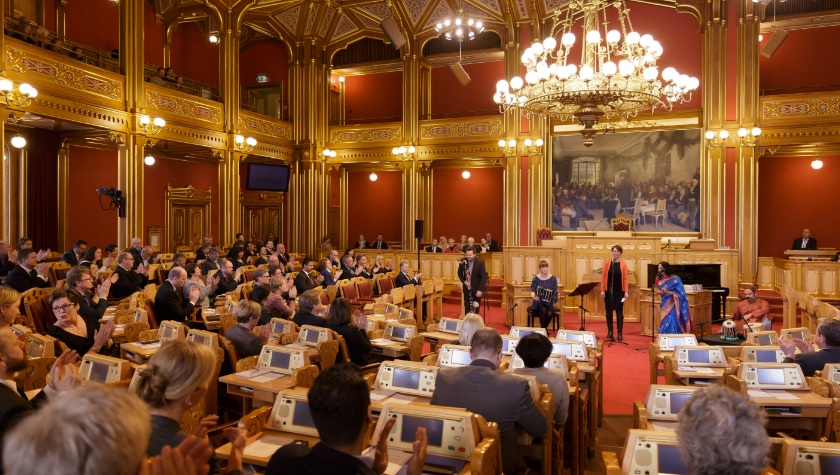
Ceremony in the Storting Chamber on 3rd March. The song “Å eg veit meg eit land” was performed by vocalist Unni Løvlid (centre) and (left to right) Håvard Lund, Valeria Lillebjerka, Sunanda Sharma and Jai Shankar. Photo: Morten Brakestad/Storting.
Marking of the Storting building’s 150th anniversary on 3rd March
On Saturday 3rd March 1866 the Storting convened in borrowed premises for the very last time. Two days later the magnificent new Storting building was officially opened. The 150th anniversary of the building’s inauguration was celebrated in the Storting on Thursday 3rd March 2016.
See photos from the anniversary celebrations on 3rd March on Flickr. All photos may be freely used provided they are credited to the Storting.
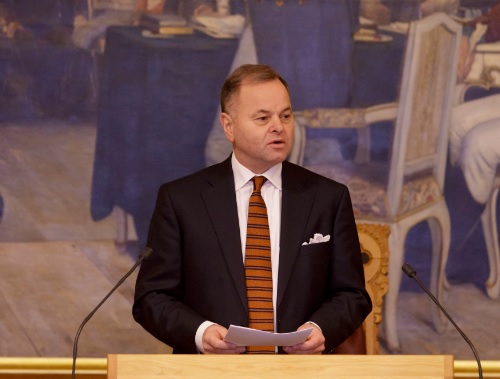
President of the Storting Olemic Thommessen speaking to the Storting during the jubilee ceremony in the Storting Chamber. Photo: Morten Brakestad/Storting.
All dressed up
The Storting building was all dressed up for the occasion, with flags on the outside and flower arrangements within. The latter were inspired by the floral decorations used during the actual opening itself on 5th March 1866.
Ceremony in the Storting Chamber
The celebrations on 3rd March were opened at 10.00 by a ceremony in the Storting Chamber. During President of the Storting Olemic Thommessen’s opening speech, he emphasized the significance of the Storting building as one of our most powerful national symbols.
“Modern Norway has been shaped in the Storting building. No other place has staged so many of our nation’s most important moments. In marking the 150th anniversary of the building, we are also celebrating what takes place inside,” he said.
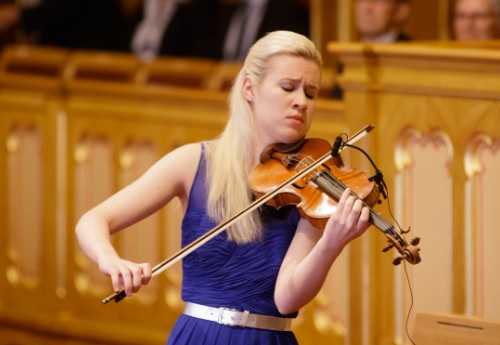
Violinist Eldbjørg Hemsing (pictured) and Tor Espen Aspaas, piano, opened the ceremony in the Chamber with the 2nd movement of Edvard Grieg’s national romantic violin sonata No. 1 in F major, Op. 8. Photo: Morten Brakestad/Storting.
After the President’s speech, the jubilee ceremony in the Chamber consisted of a number of cultural performances. The 2nd movement of Edvard Grieg’s violin sonata No. 1 in F major, Op. 8, played by Eldbjørg Hemsing on violin and Tor Espen Aspaas on piano, opened the programme.
Actor Kim Haugen followed this by performing the prologue Henrik Ibsen wrote to mark the laying of the foundation stone on 10th October 1861.
Å eg veit meg eit land, a song written by Elias Blix in 1896, brought the anniversary ceremony to its conclusion. The song was performed by Unni Løvlid and Sunanda Sharma on voice, Håvard Lund on bass clarinet, Jai Shankar on tabla drums, and Valeria Lillebjerka on bandoneon.
The ceremony in the Storting Chamber was broadcast live on the Storting’s web TV – click here to view a recording of the ceremony.
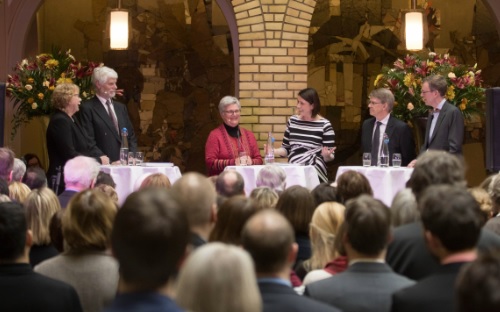
Panel discussion about the history of the Storting building. From left to right: Anne Grosvold (host), Peter Butenschøn, Kirsti Kolle Grøndahl, Heidi Nordby Lunde, Leif Jakob Knutsen and Kjetil Alstadheim. Photo: Morten Brakestad/Storting.
Programme of events in the Storting’s Central Hall
The ceremony in the Storting Chamber was followed by a programme of events in the Central Hall for Members of Parliament (MPs), parliamentary staff and other invited guests. Here, there was a talk show with a panel discussion about the Storting building.
The panel discussion was hosted by Anne Grosvold, a well-known journalist and broadcaster. Before introducing her, Olemic Thommessen remarked that the Storting was a small community within itself. Grosvold added that a haircut was virtually the only thing one had to leave the building for.
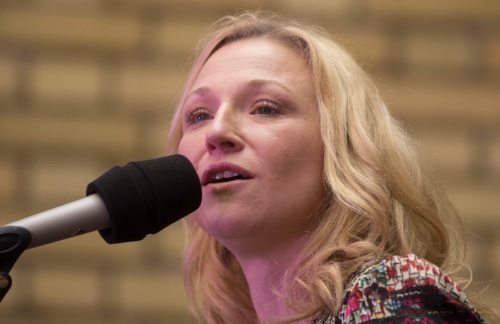
Vocalist Heidi Gjermundsen Broch (pictured) sang beautifully during the celebrations in the Storting’s Central Hall, accompanied by Espen Leite on accordion. Photo: Morten Brakestad/Storting.
The panel consisted of Peter Butenschøn, an architect and author of the jubilee book about the Storting building; Kirsti Kolle Grøndahl, a prominent former MP and to date Norway’s only female President of the Parliament; Heidi Nordby Lunde, a current MP; Leif Jakob Knutsen, a former long-serving member of the parliamentary administration, and the political commentator Kjetil Alstadheim. Curiosities and anecdotes about the Storting building’s innermost nooks and crannies were the order of the day.
The programme in the Central Hall also included a musical interlude. This time Heidi Gjermundsen Broch (voice) and Espen Leite (accordion) performed two songs: Vår beste dag by Erik Bye & Jon K. Rosslund, and Promenade from the musical album Leve Patagonia by Ketil Bjørnstad.
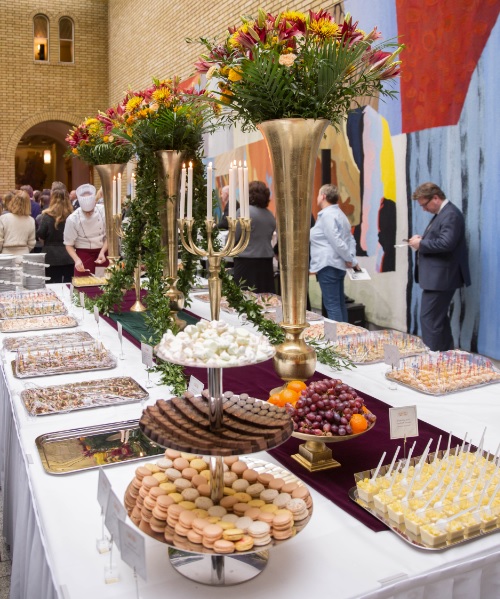
Both the menu for the day and the decoration in the Central Hall were inspired by the inauguration of the Storting building on 5th March 1866. Photo: Morten Brakestad/Storting.
At the conclusion of the afternoon’s programme, guests were invited to a buffet reception that drew inspiration from the menu served at the official opening of the Storting on 5th March 1866. Though turtle soup had been taken off the menu, among the delicacies once again on offer were brisket of beef and ox tongue.
Opening of the jubilee exhibition about the Storting building
The last item on the programme for the day was the opening of the jubilee exhibition about the Storting building in the Historical Hall. In her speech opening remarks Marit Nybakk, First Vice President of the Storting, underlined how appropriate the hall was as the venue for such an exhibition.
“The Hall lies in the very heart of the Storting building, directly below the Lagting Chamber, with its one entry point from Langlet’s building and its other from Nils Holter’s 1959 extension,” she explained.
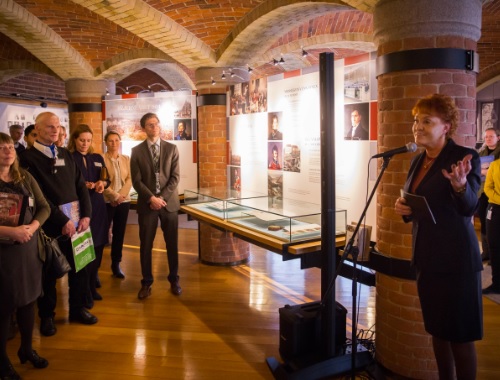
The Storting’s First Vice President Marit Nybakk opened the jubilee exhibition in the Historical Hall. Photo: Morten Brakestad/Storting.
The jubilee exhibition in the Historical Hall looks at different aspects of the Storting building’s history. One section, “Democracy’s house”, displays how from 1866 the new building became an arena for democratic development in the years that followed.
“The exhibition brings home how many monumental events this building has staged,” Nybakk said in her opening speech. “This is where it took place, everything. This is where the representatives of the people propelled Norway towards today’s welfare state; the Nordic model.”
To illustrate this the Vice President listed up many of the most important historical events that have taken place in the building. This included the introduction of parliamentarianism; the decision to dissolve the union with Sweden in 1905; the swearing in of King Haakon VII, King Olav V and the current monarch, King Harald V; and – not least – the many vital steps taken in the struggle for women’s liberation.
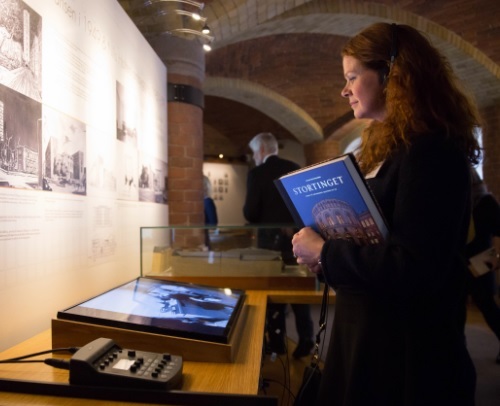
Among the items on display are 50-year-old video clips from life in the Storting, made to celebrate its centenary in 1966. These unique film clips captured the attention of several visitors, including Mari Tefre. Photo: Morten Brakestad/Storting.
A major reconstruction of Langlet’s Storting building took place in the 1950s under the leadership of the architect Nils Holter. The final section of the jubilee exhibition is called “From Langlet to Holter”, and looks at the building through these two epochs.
«The Storting building appeared in new and modern splendour in 1959,” Marit Nybakk explained in her opening speech.
“In addition to the Akersgata extension, a new main staircase and the Staircase Hall, we were given the Central Hall, now so familiar to television viewers all over the country.”
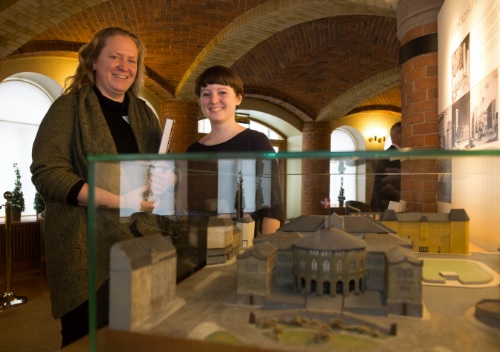
The exhibition also contains a model of the Storting building from the 1950s. Photo: Morten Brakestad/Storting.
Collaboration with the National Museum of Art, Architecture and Design
The exhibition “From Langlet to Holter” has been put together in collaboration with the National Museum of Art, Architecture and Design, which will be opening its own exhibition on 12th March.
Together the two exhibitions help to explain why the Storting building has been the subject of such extensive and heated debate over these two periods. They also show what kind of impact the building has had on architecture in general and the Members of Parliament who work here.